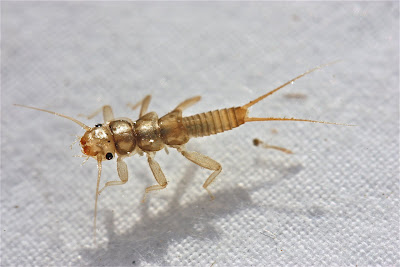Saturday, April 16, 2011
Maturation of "Diploperla" Perlodid stonefly nymphs
Since we appear to be reaching the point at which Diploperla (genus) Perlodid stoneflies are going to hatch, I thought I might do another "review of the growth stages" we can perceive if we follow them over a number of months. In the previous entries I've done of this sort (for small minnow mayflies, large winter stoneflies, etc.), I've stressed 1) changes in color (they get darker), 2) changes in the richness of detail in patterns, and 3) how the wing pads get longer. Here, the color and pattern changes are not as pronounced, but the wing pads clearly lengthen and change in shape as the nymphs mature.
But let me begin with a review of the anatomical features that help us ID this particular genus. There are two features that prove to be key. They are -- and I'm quoting Peckarsky, et.al., Freshwater Macroinvertebrates of Northeastern North America -- 1) "Posterior ends of arms of mesosternal ridge meet posterior edge of mesosternum separately," and 2) terminal lacinial spine long, 1/2 as long as lacinia." Here's a microscope shot of the Diploperla mesosternum showing the "arms" and the "posterior edge" of the mesosternum.
Clearly, the arms meet separately. This contrasts sharply with what we see when we look at the mesosternal ridge of the Perlodid genera Clioperla and Isoperla where the arms form a "Y".
Next, we look at the lacinia, and the lacinial spines of the Diploperla stonefly. We are looking at the underside of the head.
Note the length of the terminal lacinial spine in relation to the length of the lacinia as a whole. Also note that there are no "hairs" or "spinules" below the second lacinial spine -- as we would find with most other Perlodid nymphs.
On to our photos that show the Diploperla nymphs developing over time. The first photo I have in my collection comes from February. But I'm quite sure I started to see this genus in January -- at that time, they were too small to photograph at the stream.
2/13: Powells Creek. Note that the colors are much the same as they will be when the nymph is fully mature, but, look at the wing pads -- the posterior edges are almost straight across (i.e. not at all curved).
3/18. Whippoorwill Branch of the Mechum. This is not quite as dark as the mature nymph will be, but note the slight curve in the back edges of the wing pads.
4/11: Doyles River. This nymph is much darker in color, and the wing pads are longer and even more curved.
4/18: Powells Creek. Finally, the fully mature nymph -- one that's ready to hatch. Note the length and shape of the wing pads. And note that the primary and secondary wing pads are shaped differently on Perlodid stoneflies. The back edge of the primary wings forms an arch; the arms of the back edge of the secondary wings meet at an angle. And the colors and patterns are very rich. What a beautiful insect!
_____________________
(The following Diploperla nymph -- even closer to hatching than the one pictured above -- was found on 5/14 at the Lynch River. For more photos, see the entry for 5/15.)
Subscribe to:
Post Comments (Atom)









No comments:
Post a Comment